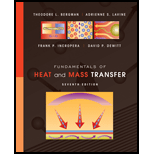
The one-dimensional plane wall of Figure 3.1 is of thickness
(a)
The minimum and maximum heat fluxes through the wall for free convection in gases.
Answer to Problem 9.1P
The minimum heat fluxes through the wall for free convection in gasses is
Explanation of Solution
Given:
The thickness of the length is
The thermal conductivity is
The fluid temperature is
Minimum heat transfer coefficient is
Maximum heat transfer coefficient is
Concept used:
Write the expression for heat flux.
Here,
Calculation:
Substitute
Therefore, the expression for heat flux is shown below.
The minimum heat flux is obtained below.
Substitute
The maximum heat flux is obtained below.
Substitute
Conclusion:
Thus, the minimum heat fluxes through the wall for free convection in gases is
(b)
The minimum and maximum heat fluxes through the wall for free convection in liquids.
Answer to Problem 9.1P
The minimum heat fluxes through the wall for free convection in liquids is
Explanation of Solution
Given:
Minimum heat transfer coefficient is
Maximum heat transfer coefficient is
Calculation:
Substitute
The maximum heat flux is obtained below.
Substitute
Conclusion:
Thus, the minimum heat fluxes through the wall for free convection in liquids is
(c)
The minimum and maximum heat fluxes through the wall for forced convection in gases.
Answer to Problem 9.1P
The minimum heat fluxes through the wall for forced convection in gases is
Explanation of Solution
Given:
Minimum heat transfer coefficient is
Maximum heat transfer coefficient is
Calculation:
Substitute
The maximum heat flux is obtained below.
Substitute
Conclusion:
Thus, the minimum heat fluxes through the wall for forced convection in gases is
(d)
The minimum and maximum heat fluxes through the wall for forced convection in liquids.
Answer to Problem 9.1P
The minimum heat fluxes through the wall for forced convection in liquids is
Explanation of Solution
Given:
Minimum heat transfer coefficient is
Maximum heat transfer coefficient is
Calculation:
Substitute
The maximum heat flux is obtained below.
Substitute
Conclusion:
Thus, the minimum heat fluxes through the wall for forced convection in liquids is
(e)
The minimum and maximum heat fluxes through the wall for convection with phase change.
Answer to Problem 9.1P
The minimum heat fluxes through the wall for convection with phase change is
Explanation of Solution
Given:
Minimum heat transfer coefficient is
Maximum heat transfer coefficient is
Calculation:
Substitute
The maximum heat flux is obtained below.
Substitute
Conclusion:
Thus, the minimum heat fluxes through the wall for convection with phase change is
Want to see more full solutions like this?
Chapter 9 Solutions
Fundamentals of Heat and Mass Transfer
Additional Engineering Textbook Solutions
Vector Mechanics For Engineers
Database Concepts (8th Edition)
Electric Circuits. (11th Edition)
Thermodynamics: An Engineering Approach
Starting Out with C++ from Control Structures to Objects (9th Edition)
Automotive Technology: Principles, Diagnosis, And Service (6th Edition) (halderman Automotive Series)
- (read image) (answer given)arrow_forward11-5. Compute all the dimensional changes for the steel bar when subjected to the loads shown. The proportional limit of the steel is 230 MPa. 265 kN 100 mm 600 kN 25 mm thickness X Z 600 kN 450 mm E=207×103 MPa; μ= 0.25 265 kNarrow_forwardT₁ F Rd = 0.2 m md = 2 kg T₂ Tz1 Rc = 0.4 m mc = 5 kg m = 3 kgarrow_forward
- 2. Find a basis of solutions by the Frobenius method. Try to identify the series as expansions of known functions. (x + 2)²y" + (x + 2)y' - y = 0 ; Hint: Let: z = x+2arrow_forward1. Find a power series solution in powers of x. y" - y' + x²y = 0arrow_forward3. Find a basis of solutions by the Frobenius method. Try to identify the series as expansions of known functions. 8x2y" +10xy' + (x 1)y = 0 -arrow_forward
- Hello I was going over the solution for this probem and I'm a bit confused on the last part. Can you please explain to me 1^4 was used for the Co of the tubular cross section? Thank you!arrow_forwardBlood (HD = 0.45 in large diameter tubes) is forced through hollow fiber tubes that are 20 µm in diameter.Equating the volumetric flowrate expressions from (1) assuming marginal zone theory and (2) using an apparentviscosity for the blood, estimate the marginal zone thickness at this diameter. The viscosity of plasma is 1.2 cParrow_forwardQ2: Find the shear load on bolt A for the connection shown in Figure 2. Dimensions are in mm Fig. 2 24 0-0 0-0 A 180kN (10 Markarrow_forward
- determine the direction and magnitude of angular velocity ω3 of link CD in the four-bar linkage using the relative velocity graphical methodarrow_forwardFour-bar linkage mechanism, AB=40mm, BC=60mm, CD=70mm, AD=80mm, =60°, w1=10rad/s. Determine the direction and magnitude of w3 using relative motion graphical method. A B 2 3 77777 477777arrow_forwardFour-bar linkage mechanism, AB=40mm, BC=60mm, CD=70mm, AD=80mm, =60°, w1=10rad/s. Determine the direction and magnitude of w3 using relative motion graphical method. A B 2 3 77777 477777arrow_forward
 Principles of Heat Transfer (Activate Learning wi...Mechanical EngineeringISBN:9781305387102Author:Kreith, Frank; Manglik, Raj M.Publisher:Cengage Learning
Principles of Heat Transfer (Activate Learning wi...Mechanical EngineeringISBN:9781305387102Author:Kreith, Frank; Manglik, Raj M.Publisher:Cengage Learning
